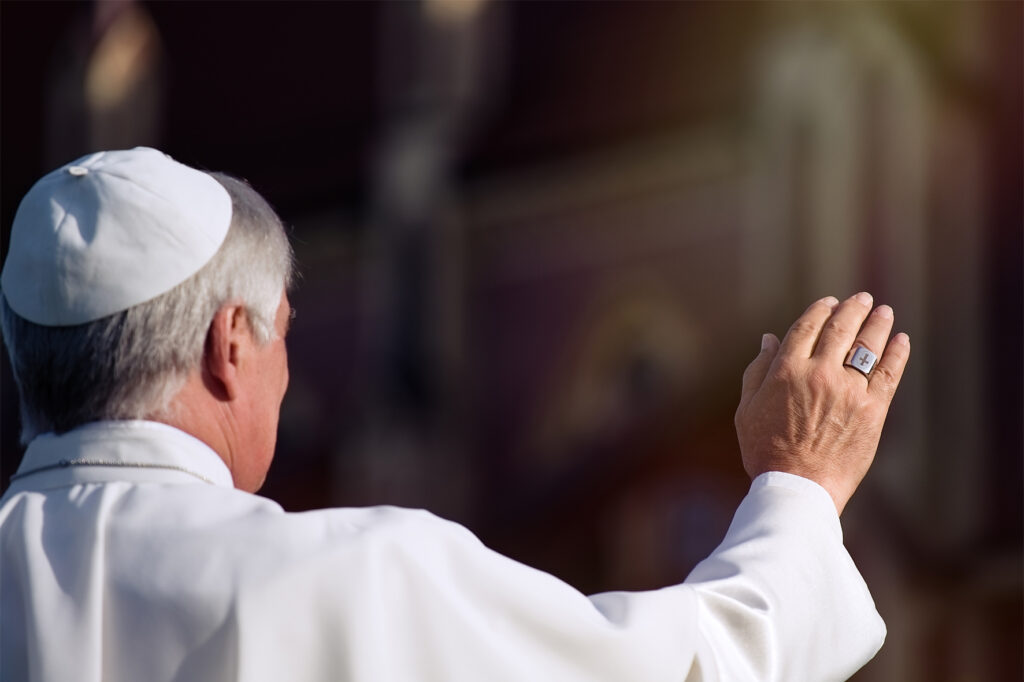The power of papal trips
The power of papal trips
In March 2021, Francis became the first pope to travel to Iraq. What is the significance of the pope’s trip and how does it compare with papal visits of the past?
In early March 2021, Pope Francis became, despite health and security warnings, the first pope to visit Iraq. Francis spent four days in the country, travelling from the capital, Baghdad, through former ISIS-held cities, like Mosul, and ending in the historic city of Erbil.[1] From an initial glance, the pope’s visit may appear somewhat surprising as Iraq has a small Christian population of about 200,000 that continues to decrease. Why then did the pope visit? This article will explore historic papal trips – by Pope Francis and his predecessors – in order to shed light on the motivations and goals for this historic COVID-era journey.
The end of 150-, 1000-, and 2000-year traditions
In 1964, Pope Paul VI made history with a visit to Israel. His trip marked the end of a 150-year streak during which no pope had left Italy. The last pope to have done so was Pius VII, who was kidnapped and taken to France by French forces during the Napoleonic Wars.[2] In fact, most popes in the century before Paul hardly left the Vatican.[3] Paul’s trip carried additional historical weight, too, as it marked the first time a pope flew on a plane and the first time a sitting pope had ever left Europe.[4] [5]
Beyond these milestones, Paul’s trip also reflected a careful geopolitical balance, a trend that has continued to run through successive papal trips. Firstly, Israel’s establishment on the international scene was still hotly contested, without a single Arab nation having recognised it. Given the controversial nature, the pope framed his trip as a pilgrimage, where he hoped to visit sites integral to the life of Christ.[6]
Though Paul did not acknowledge Israel as a country by name during his trip, the visit coincided with some of the first official movements by the Catholic Church towards normalising relations with members of the Jewish faith. The trip took place during the historic multi-year Vatican II Conference, from which came Nostra Aetate, a Catholic declaration that, amongst other things, rejected antisemitism and underlined Judeo-Catholic similarities.[7] [8] The trip also marked the warming of relationships between the Catholic Church and the Eastern Orthodox Churches, as Paul met with Ecumenical Patriarch of Constantinople Athenagoras I.[9] The next year, the two would officially end the nearly 1000-year Great Schism that had divided eastern and western Christianity since 1054,[10] when Church leaders on both sides excommunicated each other over long-simmering theological and political disagreements.[11]
Historic successes and indecisive failures
Paul’s excursion from Italy would mark the beginning of a newfound era of papal trips around the world. While many trips, like those to Brazil or the Philippines, make sense simply on a numbers basis, i.e. the pope travels to these countries to interact with large numbers of Catholic faithful, popes have also continued to wade into geopolitics with their visits.
Perhaps most famously, Pope John Paul II made several trips to his native Poland in the 1970s and 80s and, in doing so, helped stir up anti-communist sentiment amongst his fellow Poles.[12] In his first visit in 1979, he expressed support for political self-determination for Poland. A series of worker strikes would ensue, ultimately culminating with Lech Wałęsa, the leader of the labour union, signing a set of accords with a pen that depicted John Paul II.[13] In the decades that have followed, John Paul is often credited as serving as an important figure in hastening the decline of communism’s grasp over parts of Eastern Europe.[14] Yet, papal visits are not always recorded as diplomatic or humanitarian successes. Notably, John Paul II’s 1983 trip to Nicaragua has been remembered as one that stirred up more disunion than peace. Several of the pope’s actions, including publicly criticising the actions of prominent leftward leaning priests who served in the government, only widened the gap between the Church and the Sandista government.[15] [16] Similarly, despite normally generating significant Latin American support, during a trip to Chile in 2018, Pope Francis struggled to connect with Chileans and was heavily criticised for his seeming lack of empathy for victims of clerical sexual abuse.[17]
A rough classification
Overall, there appear to be several, often interconnected, motivators for modern papal trips: supporter interaction, relationship improvement, and humanitarianism.
Francis’s years as pope provide examples of each. In 2015, Francis visited the Philippines, during which he held a mass that boasted the largest papal outcome in history, with between 6 and 7 million followers in attendance.[18] This is a clear-cut example of supporter interaction. A year later, Francis stopped in Havana, Cuba. There, he met with Archbishop Kirill of the Russian Orthodox Church[19] and signed a historic joint declaration that expanded on shared beliefs and similarities between the historically oppositional institutions.[20] [21] While this certainly represented a progressive step in Catholic-Orthodox relations, others have proposed theories of deeper political meaning, especially given the Russian Orthodox Church’s close ties with the Russian government.[22] Either way, the trip serves as an example of one driven by improving relationships.
Within months of his trip to Cuba, Francis spent a day on the Greek island of Lesbos, where he expressed support for the immigrants and hoped to raise awareness for their collective plight, thereby using his travels for humanitarian purposes.[23]
Iraq trip – a combination
In light of this all, Francis’s trip to Iraq seems less out of character: it combines several of the main papal trip goals. On the one hand, Francis was able to visit with Iraqi Catholics in their home cities, something no pope has ever done before. Additionally, he also carved out time to meet with the Shia cleric, Grand Ayatollah Ali al-Sistani. Together, the two released a declaration decrying extremism and declaring Iraq as a safe space for Christians as well as Muslims.[24] Finally, Francis used his time on the trip to highlight several humanitarian issues: not only the Christian victims of violence in territory held by the Islamic State, but also the Yazidi who suffered immensely under Islamic State control.[25] Symbolically, Francis’s visit also helped establish Iraq as more stable of a country than one may think: a place capable of safely hosting a Catholic pontiff during a severe pandemic.
What do leadership, tolerance, and tension have to do with each other? Find out more on the EARS Dashboard.
[1] Pope Francis visits regions of Iraq once held by Islamic State
[2] Paul is First Pope to Travel by Air; He is also First to Venture out of Italy in 151 Years
[3] The pope had historically served as the head of the Papal States, a string of territory through Italy. This role was lost, however, to the expansion of the Kingdom of Italy during Italian unification in the 1860s and 70s (5 Memorable Trips by Popes for Better or Worse; The Papal States)
[4] Paul is First Pope to Travel by Air; He is also First to Venture out of Italy in 151 Years
[5] 5 Memorable Trips by Popes for Better or Worse
[6] 1964 : Paul VI en Terre sainte, un pèlerinage fondateur
[7] ‘Nostra Aetate’ Opened Up Catholic, Jewish Relations 50 Years Ago
[9] 1964 : Paul VI en Terre sainte, un pèlerinage fondateur
[10] Joint Catholic-Orthodox Declaration of His Holiness Pope Paul VI and the Ecumenical Patriarch Athenagoras I
[12] John Paul II’s influence key to fall of communism
[13] John Paul II’s influence key to fall of communism
[14] 5 Memorable Trips by Popes for Better or Worse
[15] 5 Memorable Trips by Popes for Better or Worse
[16] John Paul II’s sanction on Nicaraguan priest–poet lifted
[17] The Pope’s visit to Chile: the limits of the ‘Francis phenomenon’
[18] ‘Luneta Mass is largest Papal event in history’
[19] Specifically the Moscow Patriarchate of the Russian Orthodox Church.
[20] ‘Finally!’: pope and Russian patriarch meet for first time in 1,000 years
[21] Full text of joint declaration signed by Pope Francis and Patriarch Kirill
[22] ‘Finally!’: pope and Russian patriarch meet for first time in 1,000 years
[23] Pope Francis takes refugees to Rome after Lesbos visit






